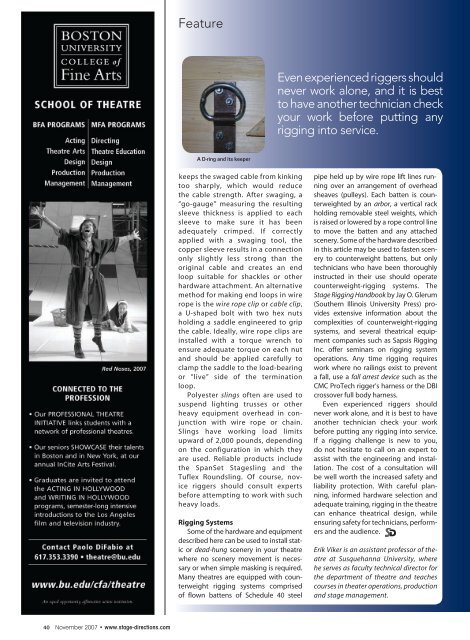Download a PDF - Stage Directions Magazine
Download a PDF - Stage Directions Magazine
Download a PDF - Stage Directions Magazine
Create successful ePaper yourself
Turn your PDF publications into a flip-book with our unique Google optimized e-Paper software.
Feature<br />
Even experienced riggers should<br />
never work alone, and it is best<br />
to have another technician check<br />
your work before putting any<br />
rigging into service.<br />
A D-ring and its keeper<br />
keeps the swaged cable from kinking<br />
too sharply, which would reduce<br />
the cable strength. After swaging, a<br />
“go-gauge” measuring the resulting<br />
sleeve thickness is applied to each<br />
sleeve to make sure it has been<br />
adequately crimped. If correctly<br />
applied with a swaging tool, the<br />
copper sleeve results in a connection<br />
only slightly less strong than the<br />
original cable and creates an end<br />
loop suitable for shackles or other<br />
hardware attachment. An alternative<br />
method for making end loops in wire<br />
rope is the wire rope clip or cable clip,<br />
a U-shaped bolt with two hex nuts<br />
holding a saddle engineered to grip<br />
the cable. Ideally, wire rope clips are<br />
installed with a torque wrench to<br />
ensure adequate torque on each nut<br />
and should be applied carefully to<br />
clamp the saddle to the load-bearing<br />
or “live” side of the termination<br />
loop.<br />
Polyester slings often are used to<br />
suspend lighting trusses or other<br />
heavy equipment overhead in conjunction<br />
with wire rope or chain.<br />
Slings have working load limits<br />
upward of 2,000 pounds, depending<br />
on the configuration in which they<br />
are used. Reliable products include<br />
the SpanSet <strong>Stage</strong>sling and the<br />
Tuflex Roundsling. Of course, novice<br />
riggers should consult experts<br />
before attempting to work with such<br />
heavy loads.<br />
Rigging Systems<br />
Some of the hardware and equipment<br />
described here can be used to install static<br />
or dead-hung scenery in your theatre<br />
where no scenery movement is necessary<br />
or when simple masking is required.<br />
Many theatres are equipped with counterweight<br />
rigging systems comprised<br />
of flown battens of Schedule 40 steel<br />
pipe held up by wire rope lift lines running<br />
over an arrangement of overhead<br />
sheaves (pulleys). Each batten is counterweighted<br />
by an arbor, a vertical rack<br />
holding removable steel weights, which<br />
is raised or lowered by a rope control line<br />
to move the batten and any attached<br />
scenery. Some of the hardware described<br />
in this article may be used to fasten scenery<br />
to counterweight battens, but only<br />
technicians who have been thoroughly<br />
instructed in their use should operate<br />
counterweight-rigging systems. The<br />
<strong>Stage</strong> Rigging Handbook by Jay O. Glerum<br />
(Southern Illinois University Press) provides<br />
extensive information about the<br />
complexities of counterweight-rigging<br />
systems, and several theatrical equipment<br />
companies such as Sapsis Rigging<br />
Inc. offer seminars on rigging system<br />
operations. Any time rigging requires<br />
work where no railings exist to prevent<br />
a fall, use a fall arrest device such as the<br />
CMC ProTech rigger’s harness or the DBI<br />
crossover full body harness.<br />
Even experienced riggers should<br />
never work alone, and it is best to have<br />
another technician check your work<br />
before putting any rigging into service.<br />
If a rigging challenge is new to you,<br />
do not hesitate to call on an expert to<br />
assist with the engineering and installation.<br />
The cost of a consultation will<br />
be well worth the increased safety and<br />
liability protection. With careful planning,<br />
informed hardware selection and<br />
adequate training, rigging in the theatre<br />
can enhance theatrical design, while<br />
ensuring safety for technicians, performers<br />
and the audience.<br />
Erik Viker is an assistant professor of theatre<br />
at Susquehanna University, where<br />
he serves as faculty technical director for<br />
the department of theatre and teaches<br />
courses in theater operations, production<br />
and stage management.<br />
40 November 2007 • www.stage-directions.com

















